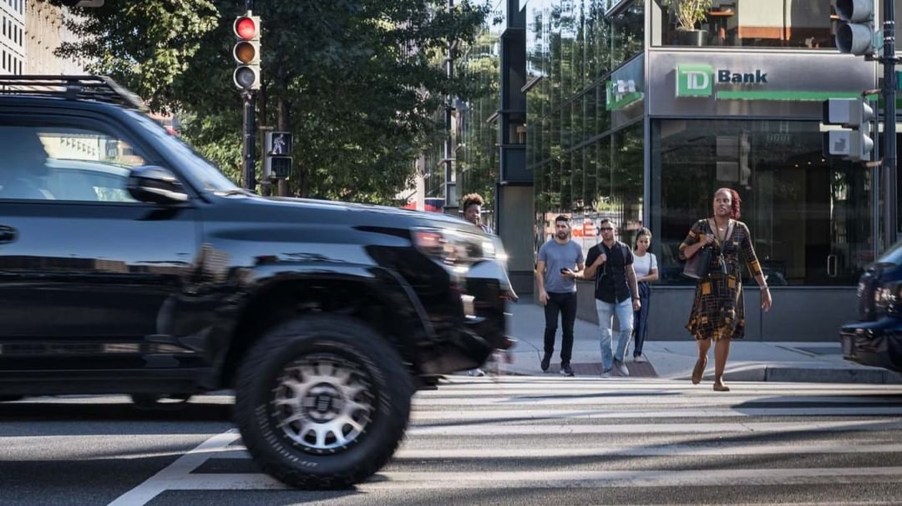
The IIHS Says Your Crossovers and SUVs Are Too Dangerous
Small cars like the Fiesta sometimes get a bad rap when it comes to safety. But the Insurance Institute for Highway Safety has found that larger vehicles like crossovers and SUVs are partially to blame for that. But the driver isn’t the only person involved in every accident. There are passengers, cyclists, and pedestrians that can also be at risk. And the IIHS’s latest study reveals that, while people inside an SUV may be relatively safe, the same can’t be said for everyone outside.
The IIHS SUV and pedestrian safety studies

The recent IIHS study is admittedly somewhat small. It covers 79 crashes from 3 “urban areas in Michigan.” However, the results do correlate somewhat with an earlier study that looked at nation-wide crashes during the 2009-2016 period.
In the Michigan-based study, the IIHS found that at speeds above 19 mph, SUVs caused more serious injuries than cars. In addition, once speeds rose, SUVs were more likely to cause pedestrian fatalities than passenger cars. In fact, above 40 mph, all SUV-pedestrian impacts recorded were fatal, as opposed to the passenger cars’ 54% fatality rate.
During the 2009-2016 period, the IIHS found that pedestrian deaths increased 46%, to a point not seen since 1990. Deaths are still down compared to 1975, but only by 20%. But that’s just fatalities—pedestrian collisions overall have increased, too. And although the majority of these collisions involved passenger cars, percentage-wise, fatal SUV collisions increased more than any other kind of vehicle.
Why is this happening?
One likely reason is that there are simply more and more crossovers and SUVs on the road. Sales of these vehicles overtook passenger cars recently for the first time. More SUVs on the road means more chances for involvement in fatal collisions. But it’s not just an increased presence that’s behind the rise.

Simply put, SUVs and crossovers are big, tall vehicles. It’s why the IIHS is devising a more-severe crash test to evaluate new vehicles. SUVs are large and heavy, and their tall grilles often by-pass normal crash structures and safety features. They also result in more injuries to pedestrians, Autoblog reports, specifically to the chest and pelvis. And all that weight means more energy, which means people and objects get flung further.
To be fair, trucks are more of a danger to passenger cars than crossovers and SUVs these days. But even a small car has airbags and a metal frame. Pedestrians, cyclists, and motorcyclists have no such safety features.
And traditionally, pedestrian safety hasn’t been as strongly-tested in the US as it has in, for instance, Europe. That’s why the Jeep Wrangler, even before the crash-test rollover, got such a poor Euro NCAP safety rating. Its boxy, rugged design doesn’t lend itself well to keep pedestrians safe.
Then there’s the rise of driver-assistance features. True, ADAS features like blind-spot monitoring and automatic emergency braking have been statistically shown to reduce accident rates. But AAA reports that almost 80% of surveyed drivers don’t know the limitations of these systems. Almost 40% of drivers, Forbes reports, don’t know forward-collision warning is not the same as automatic emergency braking.
What can be done going forward?
The IIHS is not a government agency, and as such, can only recommend new policies, not enact them. But both the IIHS and NHTSA are starting to take pedestrian safety standards more seriously. The NHTSA claims its updated crash test standards should be announced sometime in 2020. These will likely mean SUVs and crossovers will begin to shift towards more pedestrian-friendly designs. But that will take at least a few years to fully implement.
In the meantime, it’s important that SUV, crossover, and passenger car drivers realize the roles they play in pedestrian and other road-user safety. Know how to safely operate your vehicle, which includes understanding visual blind spots. Don’t drive distracted. Keep a safe following distance.
And most importantly, no matter what the advertisements say, no vehicle, no matter what ADAS features it has, is “self-driving.” Even with adaptive cruise control and lane-keeping assist, the driver must pay attention while driving. That makes these vehicles, at best, “partially-autonomous.”
Understand that, just because you are behind a mass of metal, airbags, and sensors don’t mean everyone else is.
Follow more updates from MotorBiscuit on our Facebook page.


